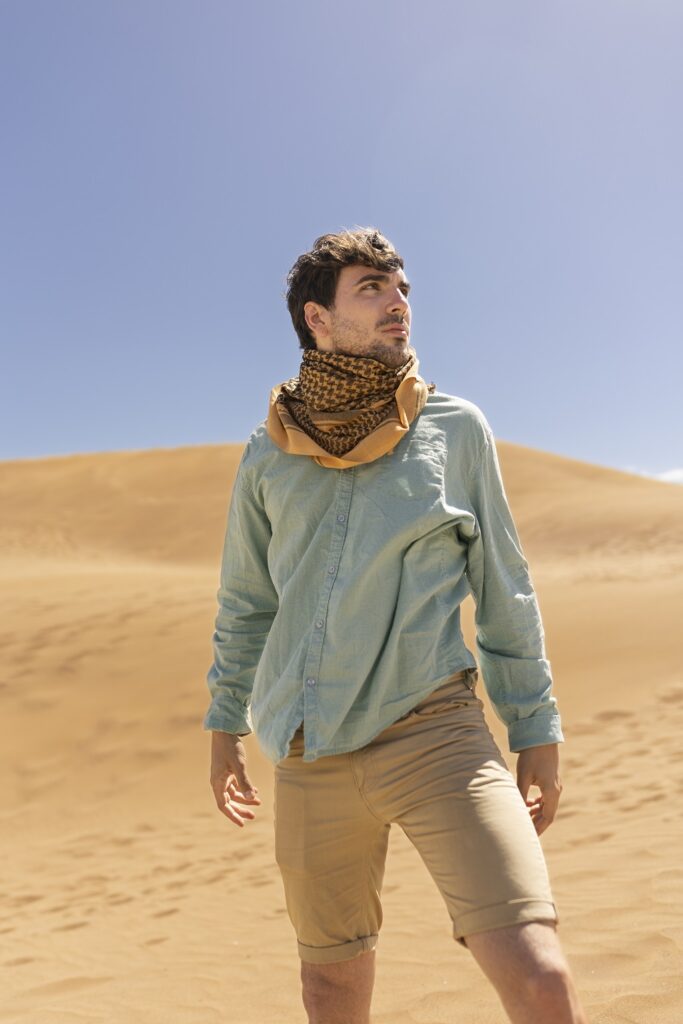How to Dress in Desert
Deserts, with their vast expanses of hot and arid terrain devoid of shade and water, pose a unique set of challenges for travelers. Yet, navigating these harsh landscapes can result in a rewarding and enduring experience. As you plan your desert journey, the question of appropriate attire undoubtedly looms large. What should you wear in the desert, and how can you ensure comfort and protection from the unforgiving elements? This guide aims to answer these questions, offering insights into essential clothing choices and tips to make your desert adventure both enjoyable and safe.Choosing Desert-Ready Clothing
When it comes to dressing for the desert, opt for loose-fitting, lightweight garments crafted from breathable materials such as cotton or linen. These choices facilitate ventilation, keeping you cool under the relentless desert sun. Donning a wide-brimmed hat, sunglasses, and sunscreen becomes crucial to shield yourself from the sun’s intense rays. Additionally, closed-toe shoes are essential to safeguard your feet from the scalding sand and potential hazards. Prioritizing coolness, protection, and hydration should guide your clothing choices for the desert.Traditional Attire Across Desert Regions
Traditional desert clothing varies across countries, each designed to help individuals adapt to the challenging desert environment. In Iran, for instance, loose, flowing garments like long robes or dresses made from lightweight fabrics such as cotton or silk are common. These outfits offer sun protection while allowing air circulation to maintain coolness. Headscarves or turbans are often worn to shield the head and face from the sun and blowing sand. In countries like Saudi Arabia and the United Arab Emirates, traditional clothing includes the “thobe” for men and the “abaya” for women—long, loose-fitting robes made from breathable materials like cotton. Men may also wear head coverings like the “ghutra” or “kufiyya” to provide shade and protection against sandstorms. These traditional choices reflect the practical need for protection in extreme desert conditions while respecting local customs.Choosing Desert-Appropriate Colors
Selecting the right colors for desert attire is crucial. Opt for light-colored clothing in shades like white, beige, or light tan. Light colors reflect the sun’s heat, aiding in temperature regulation. They also enhance visibility, making it easier for others to spot you if assistance is required. Neutral tones are advisable to mask dust and dirt, preventing your clothing from appearing excessively soiled. Conversely, avoid dark colors like black, as they absorb heat and contribute to a heightened sense of warmth. In summary, embracing light colors ensures both comfort and safety in the desert environment.What to Wear in the Desert (Female)
For women venturing into the desert, the key is to don loose and lightweight attire. Opt for a flowing dress or loose pants paired with a breathable top made from fabrics like cotton or linen to combat the desert heat. To shield yourself from the strong sun, essential accessories include a wide-brimmed hat, sunglasses, and sunscreen. Consider closed-toe shoes, such as sandals with secure straps, for both comfort and practicality. Carrying a scarf or bandana adds an extra layer of sun and sand protection, ensuring a comfortable and sun-safe experience in the desert.Nighttime Attire in the Desert
As the desert cools down at night, preparation becomes crucial. Opt for long pants and a long-sleeved shirt to ward off the chill. Bringing along a lightweight jacket or sweater is advisable to stay comfortable as temperatures drop. Don’t forget to keep a scarf or shawl handy for extra coverage if the wind picks up. Closed-toe shoes remain a wise choice, protecting your feet from the cooler desert sand. Prioritizing warmth and comfort is essential for enjoying the desert under the night sky.Summer Desert Exploration
Exploring the desert during scorching summer months demands careful consideration of clothing and gear. Start with appropriate footwear; walking barefoot on hot desert sand can cause burns and discomfort. Opt for cool yet fully covered shoes to protect your feet from the blazing ground and potential hazards. Given the intense summer heat, full sun protection is paramount. Equip yourself with a hat, sunshade, and sunglasses to prevent sunburn and excessive heat exposure. A well-designed desert hat should feature a double layer, provide ample shade, sport light colors, and include a neck cover for protection against insects and sunburn. Choose lightweight, natural-fiber shirts and pants for optimal comfort. Applying sunscreen to exposed skin is a must. For the cooler desert nights, consider carrying a small blanket or a light jacket to stay warm. Embracing these measures ensures a safe and enjoyable desert experience during the summer months.Choosing the Right Footwear for the Desert
When it comes to footwear for the desert, practicality and protection take precedence over style. High heels and fancy shoes have no place in the harsh desert environment. Instead, opt for the reliability of good-quality desert boots, especially if traversing rugged terrains. These boots boast high ankle support and a sturdy sole, offering defense against potential hazards like snakes, scorpions, and thorny plants. Not only do they make walking on sand and uneven ground more manageable, but they also safeguard your feet and ankles. Selecting the right desert boots involves ensuring a proper fit and prioritizing lightweight options to prevent fatigue. Look for boots with leather uppers and plastic soles to prevent sand from infiltrating. While desert sandals can provide ventilation and coolness, caution is advised to avoid burns or encounters with wildlife. Carrying a pair of sandals for breaks or when in the vehicle is a practical idea. Alternatively, hiking boots designed for desert conditions can offer durability and support. Breathability is a crucial feature for desert footwear, ensuring your feet remain comfortable. Opting for light-colored shoes can further help reflect heat away from your feet.Merino Wool: A Desert-Friendly Fabric
For desert style and clothing, particularly during tours and exploration, Merino wool emerges as an excellent choice. Nomadic people in the Sinai Peninsula’s desert historically used Merino wool to stay cool during hot days and warm on cold nights. Merino wool possesses unique qualities that make it ideal for desert clothing:1. Temperature Regulation:
Merino wool traps dead air, regulating body temperature to keep you warm and wicking away moisture to cool you down—a perfect choice for desert climates.2. Odor Resistance:
Naturally resistant to odors, Merino wool ensures you stay fresh even in the heat of the desert.3. Moisture Management:
Highly breathable, Merino wool fabric quickly wicks away moisture, keeping you dry and comfortable in the desert heat.Final Thoughts
Proper clothing in the desert is not just about fashion; it’s a practical necessity for comfort, health, and safety. Embrace lightweight, breathable clothing, sun-protective gear, and sturdy footwear to make the most of your desert adventure while minimizing the risks of extreme heat and sun exposure. Make sure to keep yourself well-hydrated and pause for breaks in shaded areas when necessary. By adhering to these simple guidelines on desert dressing, you can fully immerse yourself in the beauty of this spectacular landscape with a safe and enjoyable experience.





Discover Marc Jacobs savings today at the marc jacobs factory outlet online.
Wow, fantastic weblog structure! How long have you been running a blog for?
you made blogging glance easy. The whole glance of your site is excellent,
let alone the content material!
I like what you guys tend to be up too. This sort of clever work and exposure!
Keep up the terrific works guys I’ve incorporated you guys to
blogroll.